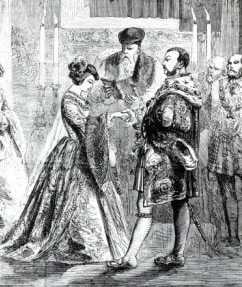 On 25 January 1533, St Paul’s Day, Henry VIII married Anne Boleyn in a secret ceremony at Whitehall.
On 25 January 1533, St Paul’s Day, Henry VIII married Anne Boleyn in a secret ceremony at Whitehall.
In a letter to Archdeacon Hawkyns, written in June 1533 and recording Anne Boleyn’s coronation, Cranmer wrote:
“But now, sir, you may not imagine that this coronation was before her marriage; for she was married much about St Paul’s Day last, as the condition thereof doth well appear, by reason she is now somewhat big with child.”1
Cranmer went on to challenge the rumours that he had performed the ceremony:-
“Notwithstanding it hath been reported throughout a great part of the realm that I married her; which was plainly false, for I myself knew not thereof a fortnight after it was done.”2
So secret was the marriage ceremony that even Cranmer had been kept in the dark until a couple of weeks afterwards and Eustace Chapuys, the imperial ambassador, was still writing to the Emperor at the end of March about rumours of a wedding being planned before Easter. Little did he know that Anne and Henry were already married. The marriage was kept secret because Henry VIII marriage to Catherine of Aragon had still not been annulled.
The Catholic apologist, Nicholas Harpsfield gave more details of the wedding in his “A Treatise on the Pretended Divorce between Henry VIII and Catharine of Aragon” written in Mary I’s reign, and confirmed that it had been Rowland Lee who had officiated at the ceremony:
“The first whereof was that the King was married to [the] Lady Anne Bulleyne long ere there was any divorce made by the said Archbishop [of Canterbury]. The which marriage a was secretly made at Whitehall very early before day, none being present but Mr Norris and Mr Henage of the Privy Chamber and the Lady Barkeley, with Mr. Rowland the King’s chaplain, that was afterward made Bishop of Coventry and Lichfield. To whom the King told that now he had gotten of the Pope a lycence to marry another wife, and yet to avoid business and tumult the thing must be done (quoth the King) very secretly ; and thereupon a time and place was appointed to the said Master Rowland to solemnize the said marriage.”3
Harpsfield goes on to describe how when a troubled Lee asked to see the licence so that it could be read to all present “or else we run all and I more deep than any other into excommunication in marrying your grace without any baynes asking, and in a place unhallowed, and no divorce as yet promulged of the first matrimony”, the King replied, “I have truly a lycence, but it is reposed in another sure[r] place whereto no man resorteth but myself, which, if it were seen, should discharge us all. But if I should, now that it waxeth towards day, fetch it, and be seen so early abroad, there would rise a rumour and talk thereof other than were convenient. Goe forth in God’s name, and do that which appertaineth to you. I will take upon me all other danger.”4 Lee had two choices: ask for the licence, showing that he did not trust his King, or get on with the ceremony, and I don’t think he can be blamed for going ahead with the marriage.
This wedding ceremony may not have been the first that Henry and Anne went through. Chronicler Edward Hall records that the couple got married secretly on St Erkenwald’s Day 1532, i.e. 14 November:
“The kyng after his returne, maried priuily the lady Anne Bulleyn, on sainct Erkenwaldes daie, whiche mariage was kept so secrete, that very fewe knewe it, til she was greate with child, at Easter after.”5
Hall is the only contemporary source to record this secret wedding, but it is plausible that the couple went through some kind of betrothal or marriage ceremony on their return from Calais because they began co-habiting then and Anne was pregnant with Elizabeth by the ceremony on 25 January.
(Based on an extract from On This Day in Tudor History)
- Miscellaneous writings and letters of Thomas Cranmer, edited by Rev. John Edmund Cox, p246
- Ibid.
- A Treatise on the Pretended Divorce between Henry VIII and Catharine of Aragon, Nicholas Harpsfield, p234-235
- Ibid, p235
- Hall’s Chronicle, Edward Hall (d.1547), p794
Also on this day in history…
- 1554 – Thomas Wyatt the Younger raised his standard in Maidstone and other rebels in Kent made simultaneous proclamations in Rochester, Tonbridge, Malling, and Milton. It was the start of Wyatt’s Rebellion.